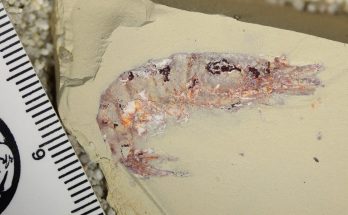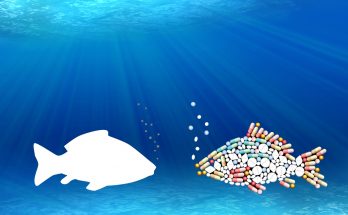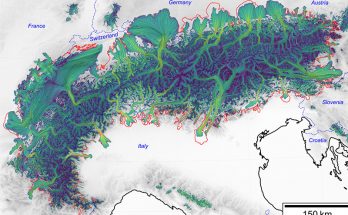Cette publication est également disponible en :
![]() Français
Français
An international team coordinated by Johanna Marin Carbonne (ISTE) has successfully measured micropyrites in modern microbial mats, in Cuba and Mexico. They present their results in a new publication of Geochemical perspective letters.
The biological activity of microorganisms can trigger the formation of certain rocks, called microbialites1. Currently, microbialites occur in a wide variety of environments, in both fresh and salt water. The microbialites host very diverse microbial communities. These microorganisms impact biogeochemical cycles and induce the precipitation of particular mineral phases, such as pyrite, a mineral composed of iron and sulfur. Studying these minerals allows us to better understand the interactions between living organisms and the surface environments of our planet.
An international team of researchers has analysed – on a very small scale – the pyrites in microbialites from an alkaline volcanic lake in Mexico and a marine hypersaline lagoon in Cuba on a small scale. A combination of state-of-the-art techniques (including CASA NanoSIMS) have permitted to observe these pyrites at very high magnification and determine their isotopic compositions (their light and heavy sulfur contents). The pyrites present in the two very different environments studied turned out to be remarkably similar isotopically: they have the same light sulfur contents. This composition is typical of a production by microorganisms.
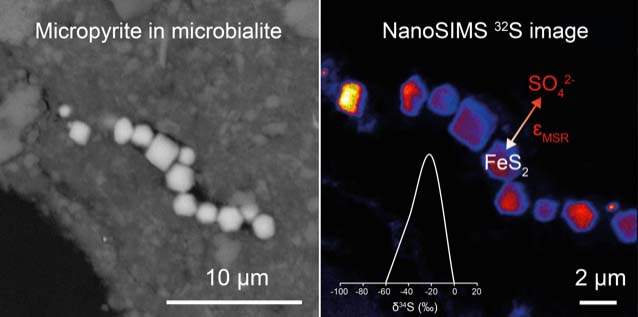
On the left, pyrites (FeS2) in a microbialite appear in white, thanks to scanning electron microscope images (Cayo Coco, Cuba). On the right, an image of S-isotopic composition acquired in NanoSIMS. Pyrites appear as blue and red gradients, as they have variable compositions. The isotope distribution is plotted in white. This composition is typical of the result of a bacterial metabolism (microbial sulfato reduction). These pyrites have therefore recorded microbial biological activity and can be considered as biosignatures (Crédit : J. Marin-Carbonne).
Pyrites formed by microbial activity are hence different from pyrites that form without the intervention of living organisms. The authors therefore propose to use these pyrites as biosignatures: their identification in very old rocks could allow to reveal the presence of microorganisms at very remote times. This would offer a new vision of the environments present on the surface of our planet a very long time ago. This result underlines in a corollary way the limits of the use of pyrites for reconstructions of global paleoenvironments, since pyrites resulting from a microbial activity are different from abiotic pyrites.
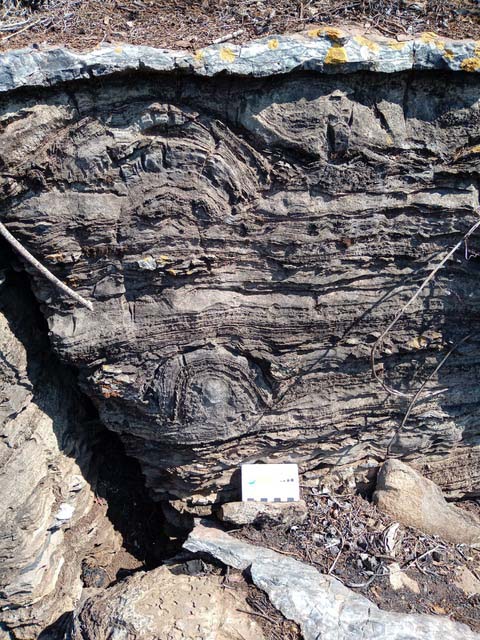
This study was coordinated by Johanna Marin-Carbonne, assistant professor at the University of Lausanne, thanks to a European H2020 program (ERC Starting Grant STROMATA). It involves two PhD students (Marie Noëlle Decraene and Robin Havas) and several post-doctoral researchers (Julien Alleon, Virgil Pasquier, Nina Zeyen). Many partners have contributed to this work: different French laboratories (IMPMC, Paris, Biogéosciences, Dijon, Magma et Volcans, Clermont-Ferrand), the Weizmann Institute (Israel), the University of Alberta (Canada), the Laboratory for Biological Geochemistry of EPFL and the University of Lausanne. The analytical protocol was developed and calibrated on the NanoSIMS of MNHN (Paris) and the joint UNIL-EPFL Center for Surface Analysis (CASA).
Bibliography
J. Marin-Carbonne, M.-N. Decraene, R. Havas, L. Remusat, V. Pasquier, J. Alléon, N. Zeyen, A. Bouton, S. Bernard, S. Escrig, N. Olivier, E. Vennin, A. Meibom, K. Benzerara et Ch. Thomazo (2022) Early precipitated micropyrite in microbialites: A time capsule of microbial sulfur cycling. Geochemical perspective letters.
